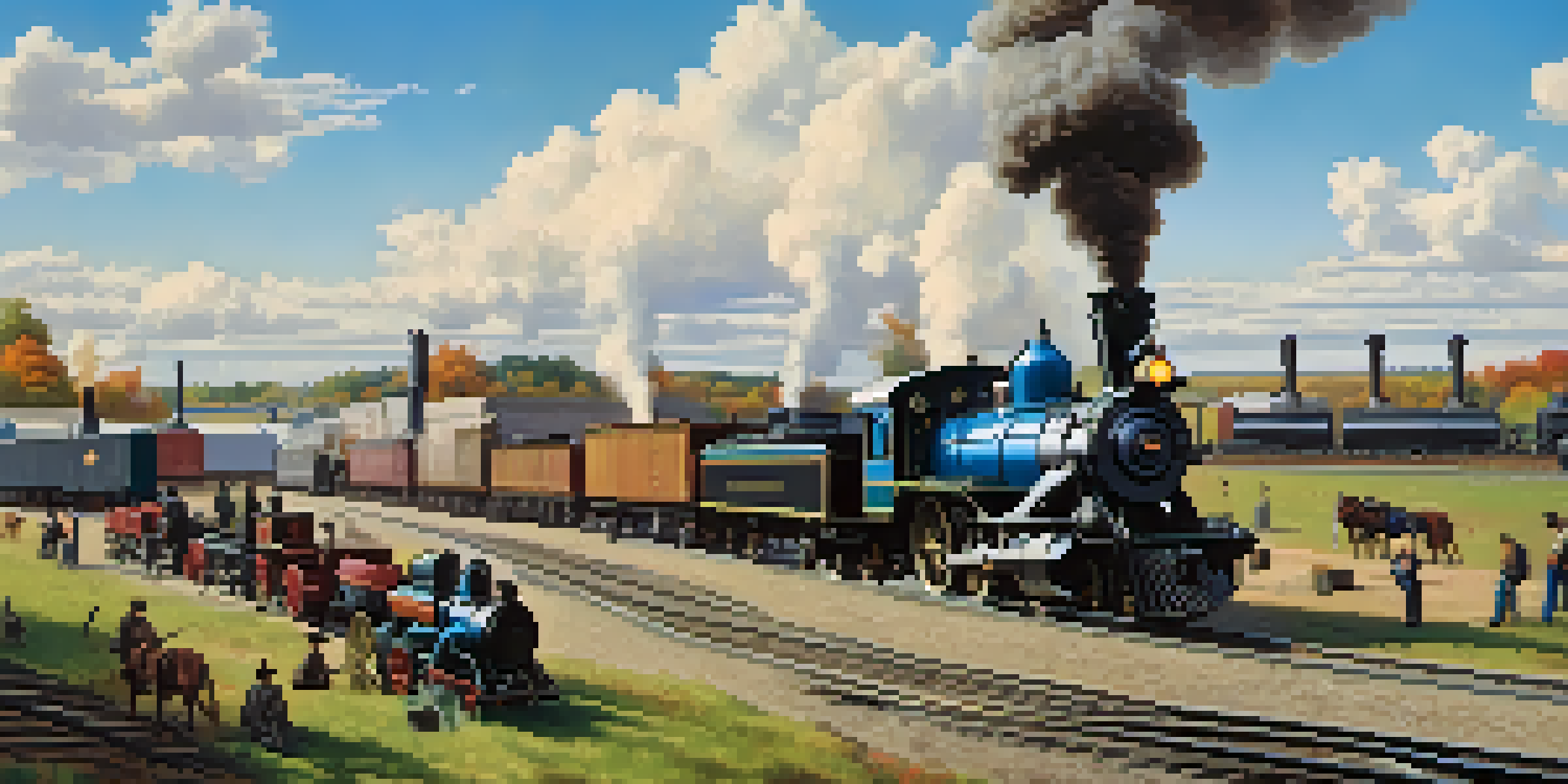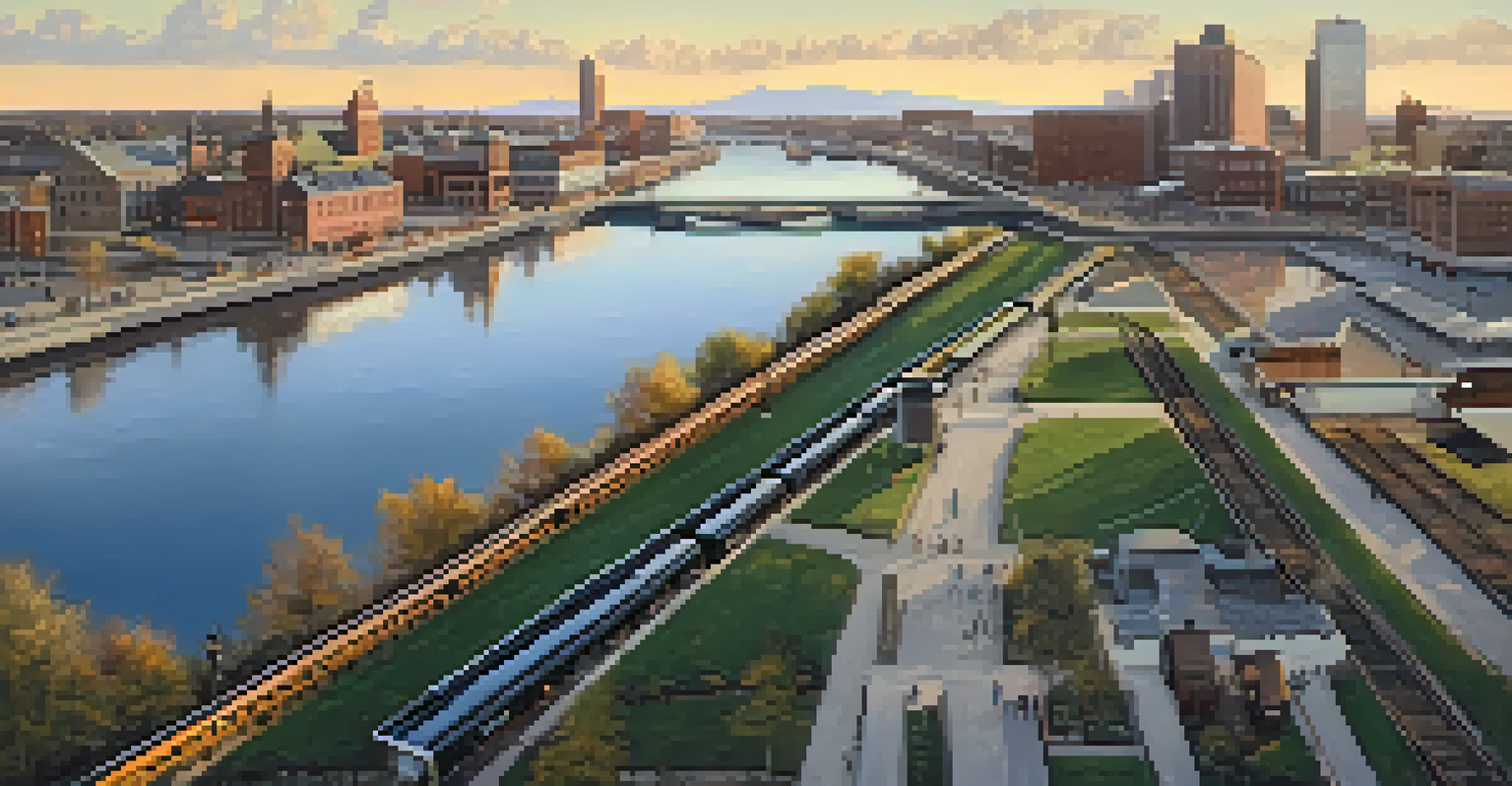The Impact of Railroads on Buffalo's Trade Economy

Introduction to Buffalo's Trade Landscape Before Railroads
Before the advent of railroads, Buffalo's trade economy was heavily reliant on waterways and horse-drawn transportation. The Erie Canal significantly contributed to Buffalo's growth, making it a bustling hub for shipping goods. However, this method had limitations, especially regarding speed and capacity. As the demand for quicker and more efficient transport grew, the need for railroads became undeniable.
The railroads are the arteries of this economic expansion, pumping life into Buffalo's trade ecosystem.
Buffalo, situated at the eastern end of the Great Lakes, was surrounded by rich agricultural lands and burgeoning industries. This strategic location made it a natural choice for trade but also highlighted the inefficiencies of existing transport methods. Goods would often sit for days waiting to be loaded onto ships or wagons, causing delays and increasing costs for businesses. The vision for a more connected and efficient system began to take shape.
The groundwork for Buffalo's transformation was laid, setting the stage for the railroads to take center stage in its trade economy. With the promise of speed and reliability, railroads were about to change the face of commerce in Buffalo forever.
Railroads: A Game Changer for Buffalo's Economy
The introduction of railroads in the mid-19th century was nothing short of revolutionary for Buffalo. Suddenly, goods could be transported across long distances in a fraction of the time it took by canal or road. This transformation allowed local businesses to expand their reach, tapping into new markets that were previously out of reach. Buffalo became a vital link in the trade network between the Midwest and the East Coast.

The railroads facilitated the movement of bulky goods like coal, grain, and timber, which were abundant in the surrounding areas. This not only boosted local industries but also attracted new businesses to the region. As trade flourished, the city saw a surge in job creation, drawing workers from across the country looking for opportunities in this booming economy.
Railroads Revolutionized Trade
The introduction of railroads transformed Buffalo's economy by enabling faster transportation of goods, connecting local industries to broader markets.
Moreover, railroads contributed to the establishment of a more diverse economy. As Buffalo's reputation as a trade hub grew, it began to attract various industries, including manufacturing and retail, leading to a more balanced economic landscape. The railroads were the arteries of this economic expansion, pumping life into Buffalo's trade ecosystem.
The Role of Railroads in Boosting Local Industries
Railroads played a critical role in the growth of local industries by providing them with the necessary infrastructure to thrive. With quicker transport options, manufacturers could source raw materials efficiently and distribute finished products faster than ever before. This increased productivity allowed businesses to scale up operations, driving economic growth.
Railroads were not just a means of transport; they were a catalyst for the city's transformation into a thriving metropolis.
For instance, the grain industry in Buffalo benefited immensely from the railroads. Farmers from the Midwest could easily ship their harvests to Buffalo, where they were processed and exported to international markets. This not only strengthened local agriculture but also positioned Buffalo as a key player in the global grain trade.
Similarly, the timber and coal industries saw unprecedented growth as railroads allowed for easy access to these resources. This influx of materials fueled the construction and manufacturing sectors, creating a ripple effect that further solidified Buffalo's economic standing. The symbiotic relationship between railroads and local industries was pivotal in shaping the city's economic landscape.
Railroads and the Emergence of Buffalo as a Trade Hub
As railroads expanded, Buffalo emerged as a central trade hub connecting the Midwest and the East Coast. The city's strategic location and advanced rail infrastructure made it an ideal stopping point for goods in transit. This led to an increase in warehouses and distribution centers, further enhancing Buffalo's role in the national trade network.
The bustling rail yards and terminals became the heartbeat of the city's economy, teeming with activity as goods were transferred between trains and trucks. This vibrant trade environment attracted merchants and entrepreneurs, eager to capitalize on the opportunities presented by the expanding railroad network. Buffalo's reputation as a trade center grew, bringing in new investments and fostering a spirit of innovation.
Boosted Local Industries' Growth
Railroads provided essential infrastructure, allowing local manufacturers to efficiently source materials and distribute products, leading to significant economic expansion.
Furthermore, the influx of people and businesses into Buffalo due to the railroads contributed to the city's cultural and social landscape. As diverse communities settled in the area, they brought their customs and traditions, enriching Buffalo's identity. The railroads were not just a means of transport; they were a catalyst for the city's transformation into a thriving metropolis.
Challenges Faced by Buffalo's Railroad Economy
Despite the many benefits, Buffalo's railroad economy faced its share of challenges. One significant issue was the competition between rail companies, which often led to aggressive pricing strategies. While this initially benefited consumers, it put immense pressure on the profits of local businesses and rail operators alike. The sheer volume of competition created an unstable market that sometimes hindered growth.
Additionally, the reliance on railroads made Buffalo vulnerable to disruptions. Natural disasters, strikes, or economic downturns could significantly impact the efficiency of transport and, consequently, the local economy. When rail lines were damaged or disrupted, businesses struggled to receive supplies or ship products, leading to temporary downturns.
These challenges underscored the importance of diversifying transportation methods. While railroads were essential, Buffalo needed to maintain its waterways and road networks to ensure a more resilient trade economy. Finding a balance between different modes of transport became crucial for sustaining long-term growth.
The Long-Term Legacy of Railroads in Buffalo
The impact of railroads on Buffalo's trade economy is still felt today, shaping the city's identity and economic landscape. The infrastructure developed during the railroad boom laid the groundwork for modern transportation systems, including highways and freight networks. Buffalo's history as a railroad hub has left an indelible mark on its economic development.
Moreover, the growth of the railroad industry in Buffalo contributed to the city’s cultural and social fabric. As diverse populations converged in the area, they brought with them new ideas, innovations, and entrepreneurial spirit. This melting pot of cultures fostered a vibrant community that continues to thrive in Buffalo.
Challenges of Railroad Dependence
Despite their benefits, Buffalo's reliance on railroads created vulnerabilities, highlighting the need for a balanced transportation network to ensure economic resilience.
Today, Buffalo is a testament to the transformative power of railroads in shaping urban economies. The legacy of this transportation revolution not only influenced local industries but also helped define Buffalo’s role in the wider economic landscape of the United States.
Conclusion: Railroads as Catalysts for Economic Growth
In conclusion, the introduction of railroads was a pivotal moment for Buffalo's trade economy. They revolutionized transportation, enabling local industries to flourish and transforming Buffalo into a vital trade hub. The economic ramifications of this transformation were profound, leading to job creation, increased productivity, and a more diverse economic landscape.
While challenges existed along the way, the overall impact of railroads on Buffalo cannot be overstated. They facilitated connections, fostered innovation, and allowed for the growth of a vibrant, diverse community. As we look back on this chapter in Buffalo's history, it's clear that railroads were more than just trains on tracks; they were the driving force behind the city's economic evolution.

Buffalo's story is a powerful reminder of the importance of infrastructure in shaping economies. As we continue to evolve in the modern age, the lessons learned from the railroad era can guide us in creating a more interconnected and resilient economic future.